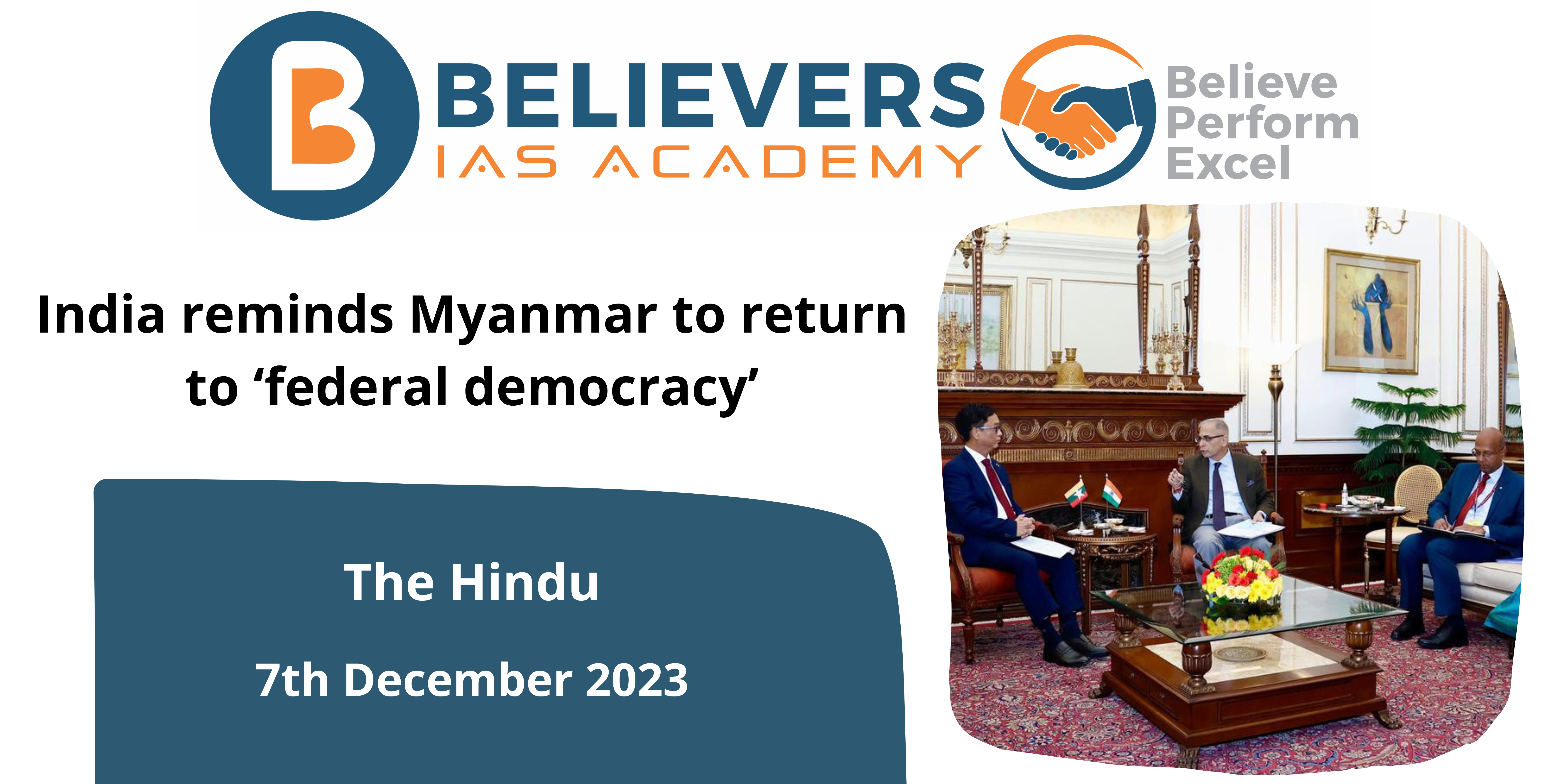India reminds Myanmar to return to ‘federal democracy’
Context
As fighting between armed opposition groups and the Myanmar military escalates in the Chin, Shan, and Sagaing provinces, India admonished Myanmar on Wednesday to return to the road of federal democracy.
What is the background of the political scenario in Myanmar?
- Myanmar, formerly referred to as Burma, has endured decades of harsh military administration, severe poverty, and ethnic minority-led civil war.
- Beginning in 2011, the shift away from full military rule raised hopes for democratic reforms. However, the military retained control of much of the government and launched an ethnic cleansing campaign against the Rohingya.
- In February 2021, the military staged a coup and then cracked down on demonstrations. The opposition established a shadow government and fighting force, resulting in a civil war and humanitarian crisis that could spread beyond Myanmar’s borders.
What is the historical background behind the Myanmar conflict?
- Colonial Legacy (19th to mid-20th century):
-
- Myanmar (previously Burma) was a British colony until it gained independence in 1948.
- The British used a divide-and-rule approach throughout colonial authority, causing ethnic and religious tensions that lingered after independence.
- Ethnic Variation:
-
- Myanmar has a diverse ethnic population, including the Bamar (Burman), Shan, Karen, Rakhine, Kachin, Chin, and others.
- Because diverse groups have varied languages, customs, and historical experiences, ethnic variety has been a source of both richness and conflict.
- Struggles after Independence (1948 onwards):
-
- Myanmar declared independence in 1948, but internal tensions arose almost immediately.
- Ethnic minority groups demanded autonomy and recognition of their rights, which sparked conflict with the central authority.
- Military rule from 1962 until 2011:
-
- Myanmar was taken over by a military coup headed by General Ne Win in 1962, creating military authority that lasted for decades.
- The military junta centralized control stifled dissent, and disenfranchised ethnic groups, further escalating ethnic tensions.
- Armed Ethnic Conflicts:
-
- Armed clashes between the military and other ethnic armed groups were commonplace.
- Ethnic communities demanded increased autonomy, control over resources, and cultural identity protection.
- The Democracy Movement and the Uprising of 1988:
-
- Pro-democracy demonstrations occurred in 1988, prompting a military response.
- Aung San Suu Kyi rose to prominence as a proponent of democracy and human rights.
- 2008 Constitution and Limited Reforms:
-
- Myanmar approved a new constitution in 2008 that guaranteed the military a strong role in governance.
- Limited political changes were implemented, resulting in Aung San Suu Kyi’s release and the NLD’s participation in the 2015 elections.
- Rohingya Crisis (since 2017):
-
- The Rohingya, a Muslim minority population in Rakhine State, were subjected to persecution and brutality, prompting a major flight to neighbouring nations.
- The military’s conduct prompted international censure for violations of human rights.
- Coup in 2021
-
- The military, led by Senior General Min Aung Hlaing, attempted a coup in February 2021, claiming voter fraud in the 2020 elections.
- The coup halted democratic progress and sparked significant protests and opposition.
- Current Conflict (Coup after 2021):
-
- The coup heightened ethnic tensions, prompting a violent response from the military and numerous resistance groups.
- As an alternative to the military junta, the National Unity Government (NUG) and People’s Defence Force (PDF) emerged.
What are the effects of the conflict on India?
- Refugee Crisis: Myanmar’s violence and instability have resulted in an influx of refugees into neighbouring countries, including India. Thousands of Myanmarese nationals, including ex-military men, have sought sanctuary in India, mainly in bordering regions.
- security concerns: The war has increased security concerns along India’s border with Myanmar. Border security can be hampered by the movement of armed organizations, refugees, and the possibility for spillover violence.
- Diplomatic Difficulties: India confronts diplomatic difficulties in managing its relationship with Myanmar, balancing worries about the military junta’s activities against historical ties and common strategic interests.
- Humanitarian Relief: India may be called upon to provide humanitarian aid to refugees and internally displaced persons (IDPs) fleeing the conflict. This could involve offering shelter, food, and medical assistance.
- The Effect on Connectivity and Trade: The violence has the potential to impair connectivity and trade between India and Myanmar. Infrastructure developments and economic links may be affected, harming both nations’ economic interests.
What is the way forward from this scenario?
- International Diplomacy: Put diplomatic pressure on the military junta to stop the bloodshed, respect human rights, and engage in constructive dialogue with all parties, including the opposition and ethnic groups.
- Multilateral Cooperation: Involve regional organizations such as ASEAN (Association of Southeast Asian Nations) and the United Nations in encouraging dialogue and finding a peaceful settlement.
- Humanitarian Relief: Mobilize international humanitarian help to confront the escalating humanitarian crisis, assisting refugees, internally displaced people, and conflict-affected communities.




